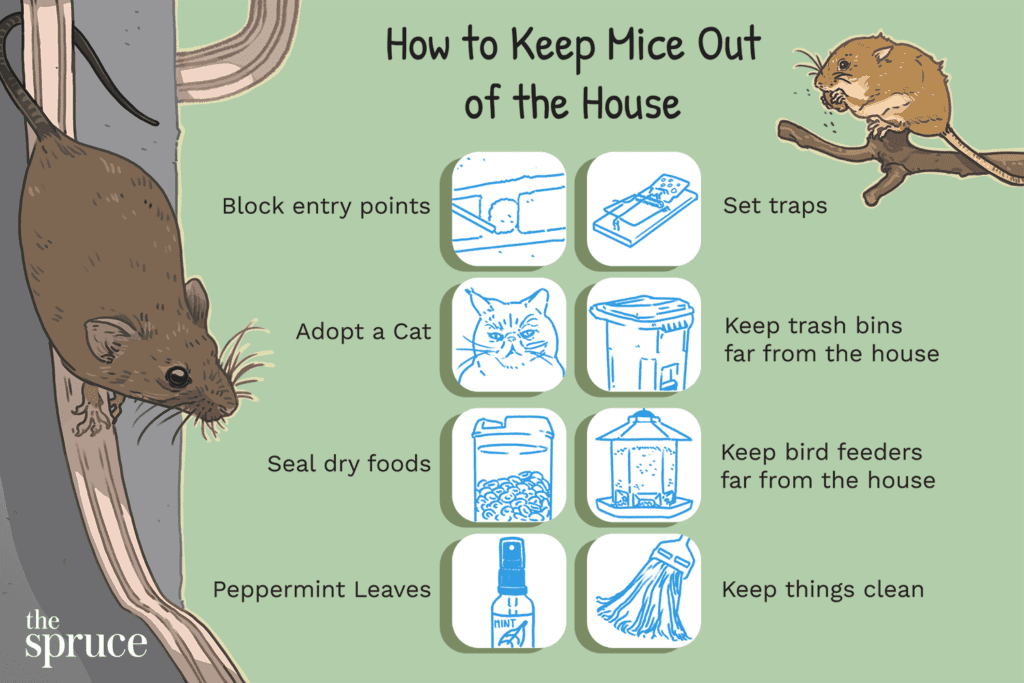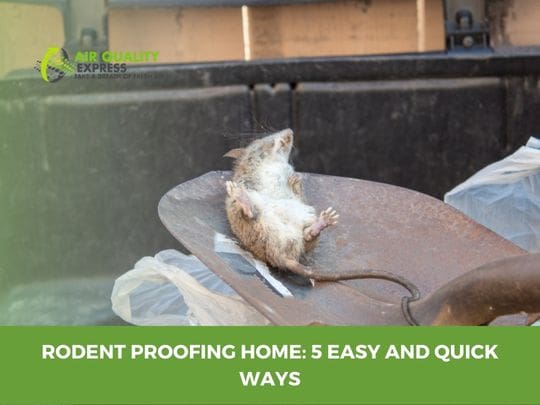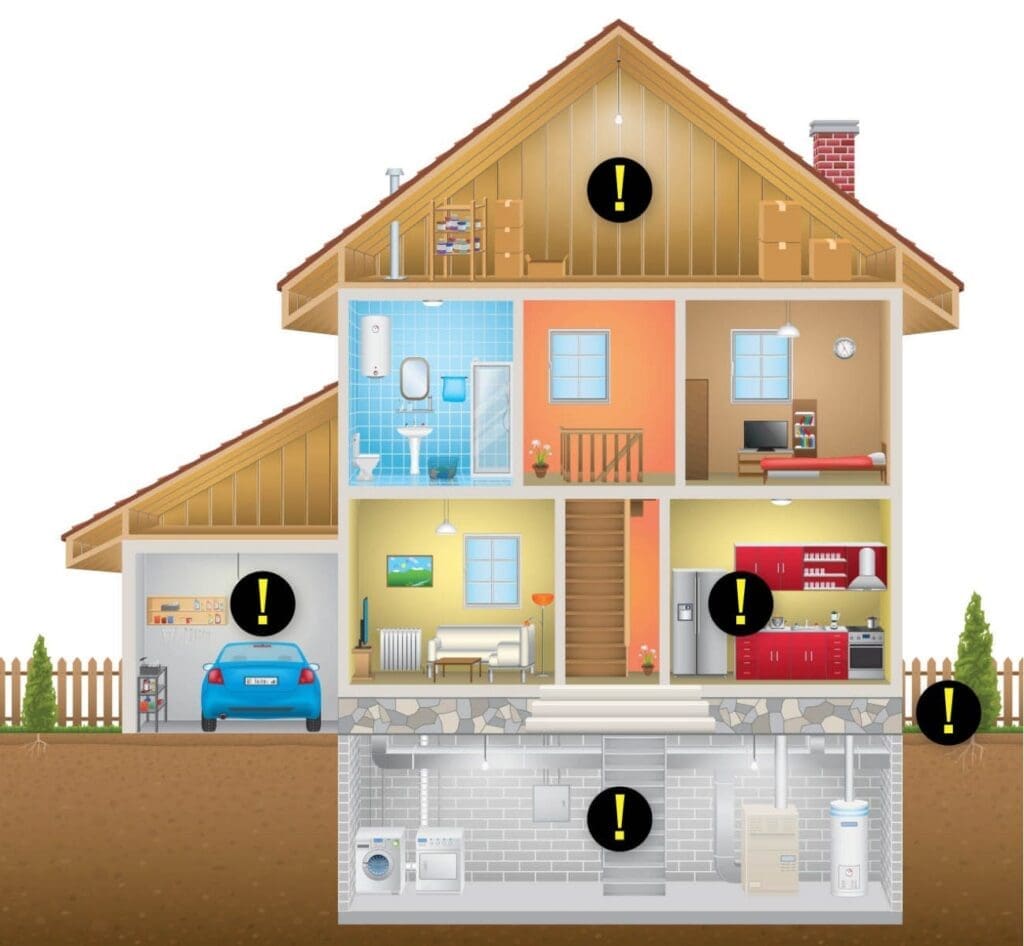Protecting your home from rodents is essential to maintain a clean and safe living environment, and our step-by-step guide is here to help you do just that. From identifying common entry points to implementing effective prevention measures, this article provides all the information you need to make your home rodent-proof. With practical tips and recommendations, you’ll be equipped with the knowledge to eliminate these pests and create an inhospitable environment for them. Say goodbye to unwanted guests and enjoy a worry-free home with our comprehensive guide.

Inspecting Your Home
Inspecting your home is an essential first step in rodent-proofing. By thoroughly examining the exterior and interior of your house, you can identify potential entry points and vulnerabilities that may attract rodents. This proactive approach allows you to take preventive measures before any rodent infestation occurs.
Exterior Inspection
Start by inspecting the exterior of your home. Walk around the perimeter and look for any cracks or openings in the walls, foundation, or roof. Rodents such as mice and rats can squeeze through extremely small gaps, so pay attention to even the tiniest holes.
Check the vents, chimneys, and crawl spaces for any openings that rodents can use to gain access to your home. Ensure that the doors and windows are properly sealed and that their frames are intact.
Interior Inspection
Once you have inspected the exterior, move on to the interior of your home. Look for signs of rodent activity, such as droppings, gnaw marks, or chewed wires. Pay special attention to areas where food is stored, such as pantries and cabinets.
Inspect your attic and basement for any signs of rodent entry points or nests. Look for shredded insulation or nesting materials, as rodents often use these to build their homes. By thoroughly examining your home, inside and out, you can take targeted action to seal off potential entry points and prevent rodents from gaining access.
Sealing Entry Points
After conducting a thorough inspection and identifying potential entry points, it’s crucial to seal them off to prevent rodents from entering your home.
Sealing Exterior Entry Points
Start by sealing any cracks or gaps you identified during the exterior inspection. Use weather-resistant sealant or caulk to fill in these openings. Pay special attention to areas around pipes, vents, and utility lines, as these are common entry points for rodents.
Install mesh screens over vents and openings to prevent rodents from squeezing through. Make sure these screens are tightly secured and in good condition to effectively block any potential entryways.
Sealing Interior Entry Points
In addition to sealing exterior entry points, it’s important to address any vulnerabilities on the inside of your home as well. Check for gaps around windows and doors and use weatherstripping or door sweeps to seal them off.
Inspect the areas where utility lines, cables, and wires enter your home. Seal any openings with caulk or steel wool to deny rodents access through these routes. By thoroughly sealing all potential entry points, you can create a barrier against rodents and significantly reduce the likelihood of an infestation.

Securing Doors and Windows
Doors and windows are common access points for rodents, and securing them properly can go a long way in preventing rodent entry.
Installing Door Sweeps
Door sweeps are an effective way to prevent rodents from squeezing through the gap under your doors. These flexible strips attach to the bottom of the door, creating a seal when the door is closed. By eliminating the space between the door and the floor, door sweeps make it much harder for rodents to enter your home.
Choose door sweeps made of durable and weather-resistant materials to ensure they last long and effectively block any potential rodent entryways.
Adding Weather Stripping to Windows
Windows are another weak point that rodents can exploit to gain access to your home. Check the condition of the weather stripping around your windows and replace any worn-out or damaged strips.
Weather stripping helps seal any gaps or cracks around windows, preventing rodents from squeezing through. Install weather stripping according to the manufacturer’s instructions, ensuring a tight seal to keep pests out.
Screening Vents and Chimneys
Vents and chimneys provide convenient entry points for rodents, so it’s important to take measures to screen them off and keep unwanted guests out.
Installing Vent Covers
Inspect all vents around your home, including those for your dryer, bathroom, and kitchen. These vents often have openings that rodents can easily slip through. Install mesh vent covers to block these entryways, ensuring that the mesh is small enough to prevent rodents from squeezing past.
Make sure the vent covers are securely attached and in good condition, as any gaps or loose fittings can render them ineffective. Regularly check and clean the vent covers to ensure proper airflow while keeping rodents out.
Screening Chimney Openings
Chimneys are another area of concern when it comes to rodent entry. Install a chimney cap or mesh screen to cover the opening and prevent rodents from climbing down into your home.
Choose a durable and rust-resistant material for the chimney cap or mesh screen to ensure longevity and effectiveness. Regularly check for any damage or blockages that may compromise the integrity of the screening and address them promptly.

Eliminating Food and Water Sources
Rodents are attracted to homes that provide them with easy access to food and water. By eliminating these sources, you can significantly reduce the likelihood of a rodent infestation.
Storing Food Properly
Store your food in airtight containers made of metal or thick plastic. Rodents can easily chew through cardboard boxes or plastic bags, so opt for rodent-proof storage containers. Keep your pantry clean and organized, regularly inspecting for signs of rodent activity.
Avoid leaving pet food out overnight and store it in sealed containers as well. Rodents are opportunistic and will gladly feast on pet food that is readily available.
Fixing Leaks and Dripping Faucets
Rodents need water to survive, and even small drips can provide enough moisture for them. Inspect your home for any leaks or dripping faucets and fix them promptly. Make sure the plumbing underneath sinks and around appliances is in good condition, as rodents can chew through damaged pipes and gain access to water sources.
By eliminating access to food and water, you remove the incentives for rodents to enter your home and make it less attractive for them to stay.
Keeping a Clean and Organized Home
Maintaining a clean and organized home not only contributes to your overall well-being but also plays a crucial role in rodent prevention.
Regular Cleaning and Vacuuming
Clean your home regularly to remove food crumbs, spills, and any potential attractants for rodents. Pay attention to areas where food is prepared or consumed, such as the kitchen and dining areas. Vacuum or sweep the floors thoroughly, including hard-to-reach corners and crevices.
Wipe down countertops, tables, and other surfaces regularly to remove any residue or food particles. A clean environment makes it less likely for rodents to find a food source, deterring them from entering your home.
Decluttering and Organizing
Clutter provides hiding places and nesting opportunities for rodents. Keep your home well-organized and free from unnecessary clutter. Regularly declutter and remove items you no longer need.
Store items in plastic bins or metal containers to make it more difficult for rodents to access them. By reducing hiding spots and nesting areas, you create an environment that is less appealing for rodents.

Maintaining Your Yard
Maintaining your yard is an important aspect of rodent prevention, as an unkempt outdoor space can attract pests and provide harborage for rodents.
Trimming Trees and Shrubs
Overgrown trees and shrubs create easy access points for rodents to enter your home. Trim back branches that come into close contact with the exterior of your house, as rodents can use them as a bridge.
Remove any ground cover, such as dense vegetation or shrubs close to the foundation, that can provide hiding spots for rodents. Keeping your yard well-maintained and vegetation trimmed helps reduce the risk of rodents finding shelter near your home.
Keeping Trash and Debris in Containers
Rodents are attracted to trash and debris, which can provide them with easy access to food and nesting materials. Keep your trash cans tightly closed and secure, and consider using lids with a locking mechanism.
Regularly empty your trash cans and clean them thoroughly to remove any lingering odors that may attract rodents. Avoid leaving piles of debris or organic waste in your yard, as these can serve as a potential food source and nesting site for rodents.
Using Pest Deterrents
In addition to preventive measures, there are various pest deterrents that can help in your rodent-proofing efforts.
Natural Deterrents
Certain scents and substances act as natural deterrents for rodents. Peppermint oil, for example, is known to repel mice and rats. Soak cotton balls in peppermint oil and place them in areas prone to rodent activity, such as attics or basements.
Other natural deterrents include cloves, ammonia, and vinegar. Sprinkle cloves or spray ammonia or vinegar around potential entry points or areas where rodents have been detected to discourage their presence.
Electronic Repellents
Electronic repellents emit ultrasonic sounds that are inaudible to humans but can deter rodents. These devices can be plugged into electrical outlets and create an environment that rodents find uncomfortable.
While electronic repellents may not be as effective on their own, they can complement other preventive measures. It’s important to keep in mind that different repellents work for different types of rodents, so choose products specifically designed for the pests you are targeting.

Monitoring and Trapping
Monitoring your home for rodent activity and using traps are additional methods you can employ to ensure rodents are kept in check.
Placing Traps in Strategic Locations
Set up traps in areas where rodent activity has been detected or where there are signs of potential entry points. Snap traps, for example, are effective in catching mice and rats. Place them along walls, near baseboards, or in areas where droppings or gnaw marks have been observed.
Consider using live traps if you prefer to capture and release rodents without causing harm. Place these traps along known rodent pathways or near potential entry points.
Regularly Checking and Emptying Traps
Check your traps regularly to see if they have caught any rodents. Depending on the type of trap used, reset them or dispose of the trapped rodents appropriately. Make sure to wear gloves and follow proper hygiene practices when handling traps or disposing of trapped rodents.
Regularly monitoring and maintaining traps ensures that you are actively addressing any rodent issues and preventing potential infestations from taking hold.
Seeking Professional Help
While DIY methods can be effective in many cases, there are situations where it may be necessary to seek professional help.
When to Call a Pest Control Service
If you have exhausted your preventive measures and are still experiencing a persistent rodent problem, it may be time to call a professional pest control service. Pest control experts have the knowledge, experience, and specialized tools to effectively deal with rodent infestations and provide long-term solutions.
Additionally, if you are uncomfortable handling traps or believe the extent of the infestation is beyond your capabilities, seeking professional help is a wise decision. They can assess the situation, identify the root cause, and develop a customized plan to eliminate the rodents from your home.
Choosing a Reliable Pest Control Company
When selecting a pest control company, it’s important to choose a reliable and reputable provider. Look for a company that is licensed and insured, as this ensures they meet the necessary requirements for operating in your area.
Read reviews and ask for recommendations from friends or family members who have used pest control services in the past. Compare quotes from different companies and ask about their treatment methods and the products they use.
By selecting a trustworthy pest control company, you can have peace of mind knowing that your rodent problem will be effectively addressed by professionals who prioritize safety and long-term solutions.
In conclusion, rodent-proofing your home is a proactive approach to prevent rodent infestations and create a safe and healthy living environment. By thoroughly inspecting your home, sealing entry points, securing doors and windows, screening vents and chimneys, eliminating food and water sources, maintaining cleanliness and organization, taking care of your yard, using pest deterrents, monitoring and trapping, and seeking professional help when needed, you can effectively minimize the risk of rodents entering your home. With a comprehensive rodent-proofing plan in place, you can enjoy a pest-free home and peace of mind.

I am Randy, the author behind PestControld.com. Drawing from decades of experience, I aim to provide valuable insights, expert advice, and practical recommendations to help you make informed decisions when assessing viable pest control solutions.